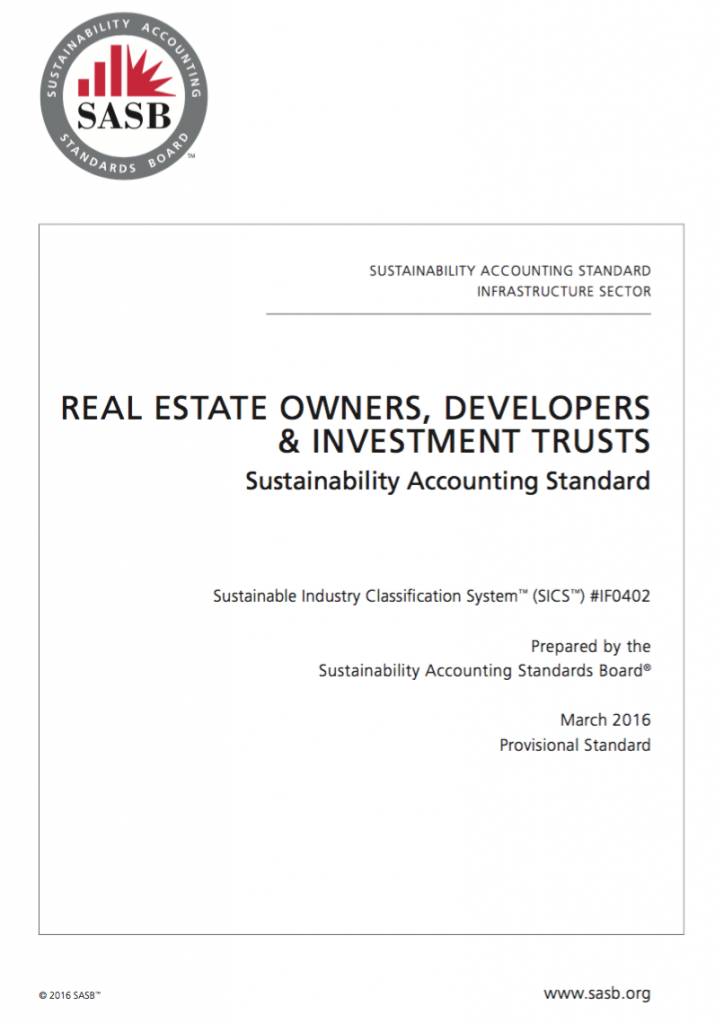For publicly traded real estate companies, the Sustainability Accounting Standards Board (better known as SASB) first gained mention two years ago when it emerged as a potential panacea to sustainability reporting fatigue. Instead of reporting on a vast array of dubious indicators to a multitude of non-governmental organizations, disclosure would simply take place within your Form 10-K or 20-F.
THE time IS NOW? 
SASB’s new standard affecting REITs, asset managers and developers was launched March 2016. Also falling under the “infrastructure sector” are home builders, electric utilities, engineering and construction services, gas utilities, waste management, and waste utilities.
The infrastructure standards marks the final set issued by SASB, which now supports a full roster of 79 industries across 10 unique sectors.
Interestingly, the set of metrics prescribed by SASB strongly aligns with GRESB, the Global Real Estate Sustainability Benchmark, and comes at time when GRESB is in the midst of launching its own reporting standard for infrastructure. In fact, SASB’s guidance explicitly mentions GRESB as the defining agency on many of its disclosures.
Whether this is an attempt to avoid reinventing the wheel, an effort to co-opt GRESB’s audience, or both is unclear. Nonetheless, the alignment is good news for companies already reporting to GRESB as it will make the transition to – or addition of -SASB simple.
The bigger problem lies in whether or not companies are ready to take the plunge of reporting sustainability metrics in a fully auditable (and enforceable) fashion to the SEC. The jury remains out.
Here’s what SASB expects you to report if you choose to take the plunge. Want to see everyone affected by the new standards? Download the complete list here.
ENERGY
| ACCOUNTING METRIC | CATEGORY | UNIT OF MEASURE |
| Energy consumption data coverage as a percentage of floor area, by property type | Quantitative | % by floor area (ft2) |
| Total energy consumed by portfolio area with data coverage, percentage grid electricity, and percentage renewable, each by property type | Quantitative | Gigajoules, (%) |
| Like-for-like change in energy consumption of portfolio area with data coverage, by property type | Quantitative | % by gigajoules |
| Percentage of eligible portfolio that (1) has obtained an energy rating and (2) is certified to ENERGY STAR®, by property type | Quantitative | % by floor area (ft2) |
| Description of how building energy management considerations are integrated into property investment analysis and operational strategy | Qualitative | n/a |
WATER
| ACCOUNTING METRIC | CATEGORY | UNIT OF MEASURE |
| Water withdrawal data coverage as a percentage of total floor area and percentage in regions with High or Extremely High Baseline Water Stress, each by property type | Quantitative | % by floor area (ft2) |
| Total water withdrawn by portfolio area with data coverage and percentage in regions with High or Extremely High Baseline Water Stress, each by property type | Quantitative | Cubic meters, (%) |
| Like-for-like change in water withdrawn for portfolio area with data coverage, by property type | Quantitative | % by cubic meters |
| Discussion of water management risks and description of strategies and practices to mitigate those risks | Qualitative | n/a |
TENant engagement
| ACCOUNTING METRIC | CATEGORY | UNIT OF MEASURE |
| Percentage of new leases that contain a cost recovery clause for resource efficiency-related capital improvements and associated leased floor area, by property type | Quantitative | % by floor area (ft2) |
| Percentage of tenants that are separately metered or sub-metered for (1) grid electricity consumption and (2) water withdrawals, by property type | Quantitative | % by floor area (ft2) |
| Description of approach to measuring, incentivizing, and improving sustainability impacts of tenants | Qualitative | n/a |
Climate Change
| ACCOUNTING METRIC | CATEGORY | UNIT OF MEASURE |
| Area of properties located in FEMA Special Flood Hazard Areas or foreign equivalent, by property type | Quantitative | Square feet |
| Description of climate change risk exposure analysis, degree of systematic portfolio exposure, and strategies for mitigating risks | Qualitative | n/a |
